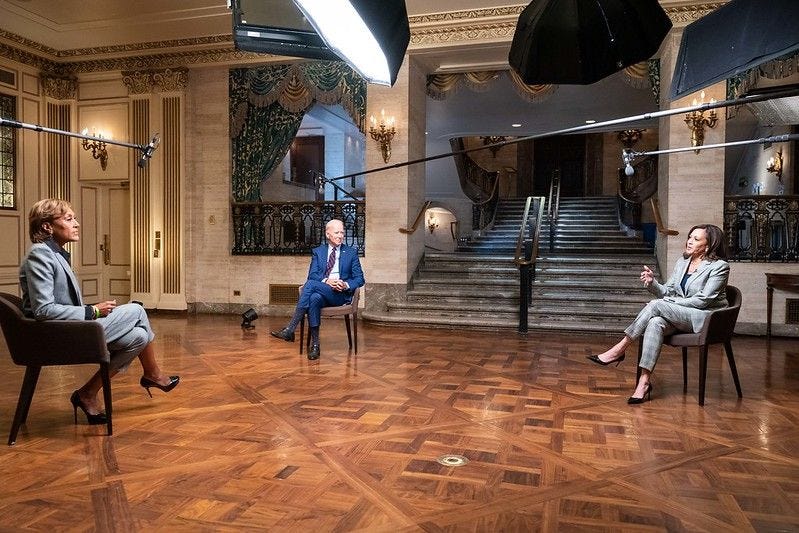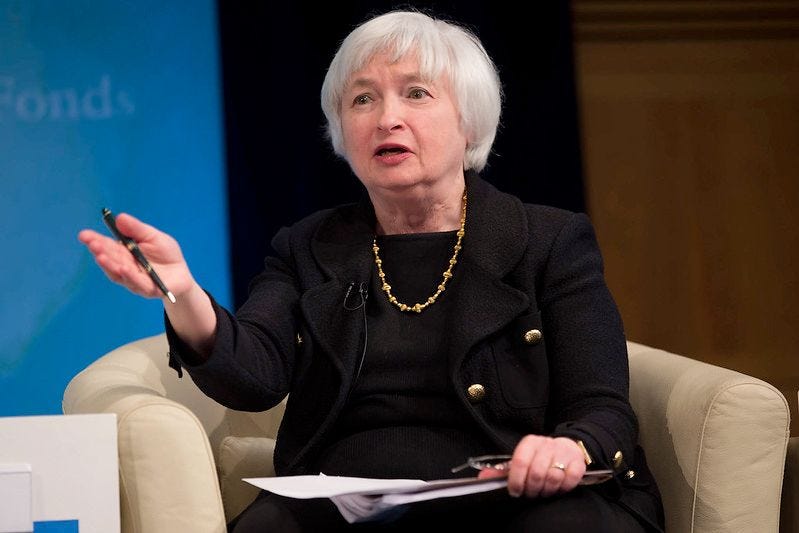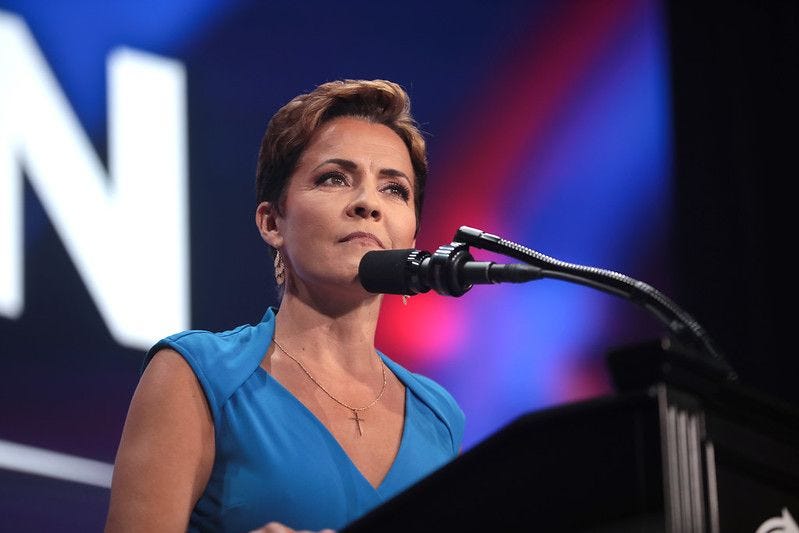Explaining the debt ceiling
If the debt ceiling is not raised in the coming months, a global financial meltdown could ensue.
Good morning! It’s Tuesday, January 17, 2023. The 2024 elections are 658 days away.
You’ve probably heard a lot about the debt ceiling lately. But what really does it mean, and why should you care about it? In this morning’s newsletter, I want to take a step back and explain what the debt ceiling is and what’s going on with the looming fight over it.
Plus, I’ll offer an update on the Biden documents scandal and answer a reader question you too might be wondering: How do so many classified documents seem to be getting lost in the first place?
📣 If this newsletter was forwarded to you, subscribe here. If you want to contribute to support my work, donate here.
EXPLAINER: What is the debt ceiling, and why does it matter?
On Friday, before most denizens of official Washington left town for the three-day weekend, Treasury Secretary Janet Yellen penned a letter to the four top congressional leaders with a dire-sounding warning.
“I am writing to inform you that beginning on Thursday, January 19, 2023, the outstanding debt of the United States is projected to reach the statutory limit,” the letter read. “Once the limit is reached, the Treasury needs to start taking certain extraordinary measures to prevent the United States from defaulting on its obligations.”
What does that mean?
For most of America history, there was no such thing as a “debt ceiling.” Every time the U.S. Treasury needed to borrow money to pay for spending that Congress had authorized, the department was required to go to Congress and receive approval before taking out that specific round of debt.
Eventually, that grew tedious, as you might expect. In 1917, Congress created the debt ceiling, which allowed the Treasury to automatically borrow up until a certain amount. When that limit would be hit, Congress would have to raise it again before the Treasury could borrow more. In all, Congress has raised the debt ceiling more than 150 times in the past 100 or so years.
In most cases, raising the debt ceiling has been routine: after all, increasing the amount of debt the U.S. can borrow does not authorize a cent of new spending. It is simply Congress allowing the country to be able to pay for the spending that Congress itself has already authorized.
What’s at stake?
If the U.S. fails to raise the debt ceiling, the country defaults on its debt. That’s never happened before, so the exact consequences are a bit murky. But economists agree that it would be catastrophic, both for the U.S. and for the global economy. Yellen warned in her letter that a default “would cause irreparable harm to the U.S. economy, the livelihoods of all Americans, and global financial stability.”
In such a scenario, the U.S. would not be able to pay its bills and meet the obligations it has already committed to. Everything from Social Security and Medicare benefits to military salaries would be in jeopardy. Just like when any borrower fails to pay their lenders, the country’s credit rating would go down and its interest rates would be forced to go up.
“Other interest rates — both domestic and foreign — would follow Treasury rates higher,” the Center on Budget and Policy Priorities explains. “Households already struggling with higher prices and interest rates would face the dual threat of far higher borrowing costs and job losses.” A global financial crisis would likely ensue.
And all of this will happen on Thursday?
No, not really. As Yellen wrote, even though the statutory debt limit — currently about $31.381 trillion — is expected to be hit on Thursday, the Treasury has “extraordinary measures” it can use to stave off a default for now.
Essentially, Yellen is empowered to move money around and draw on certain accounting tools to avoid a default. But those “extraordinary measures” can only last so long. In Washington, the date when the debt ceiling actually must be raised by is known as the “X-date.” This year, it’s believed that the debt ceiling “X-date” will arrive sometime around June.
Shades of 2011
Even approaching the debt ceiling can be harmful to the economy. The closest the U.S. has ever gotten to a default was 2011, when the debt ceiling was not raised until two days before the Treasury said it would run out of “extraordinary measures.” Here’s how the New York Times describes what happened then:
Stock prices plunged — and volatility in the market spiked — as lawmakers approached a debt limit breach. They did not recover for half a year. The cost of borrowing for corporations, which fluctuates with the level of risk that investors perceive in the economy, jumped substantially. That made it more expensive for companies to borrow to make new investments. Mortgage rates spiked similarly, hampering prospective home buyers. The credit agency S&P downgraded America’s credit rating for the first time.
And that was just from getting close to a default. “An actual breach would be far worse,” the Times added.
Now, we find ourselves in a strikingly similar situation to 2011: a newly-minted Republican House majority seeks to flex its muscles against a Democratic president, with the debt ceiling looming above them both. In all likelihood, with the potential consequences about as dramatic as can be, this will be the highest-profile clash of the 118th Congress that was just sworn in.
The current state of play
Remember that 15-ballot fight for the House speakership that took place at the beginning of this Congress, just two weeks ago? Don’t think the consequences of that have gone away. In fact, the after-effects of that conflict are intertwined with the set-up for this one.
That’s because one of the concessions House Speaker Kevin McCarthy offered conservatives to win the gavel was a promise not to accept a “clean” debt ceiling increase, one that doesn’t come with accompanying spending cuts. “You only have so many leverage and negotiating points” over federal spending, explained Rep. Chip Roy (R-TX), one of the holdouts who extracted the promise from McCarthy. “The debt ceiling is one of those.”
But the Biden White House is refusing to entertain any deal that involves cutting spending in exchange for raising the debt ceiling. “We’re not going to do any negotiations,” White House press secretary Karine Jean-Pierre said last week, insisting that the ceiling be raised “without conditions.”
It is unclear how long that posture will be able to last. In 2011, President Obama also initially demanded a “clean” increase, until eventually agreeing to $917 billion in spending cuts in exchange for a $900 billion debt ceiling increase. The deal also set up a special congressional committee (nicknamed the “Supercommittee”) to hammer out longer-term fiscal reforms, although none were ever agreed to.
The president and the speaker
A deal similar to the 2011 agreement might eventually be required here. McCarthy has been calling for a meeting with Biden to hammer out a compromise. “Let’s sit down together,” McCarthy said in a Fox News interview on Sunday. “Why would we sit back and be so arrogant to say, ‘No, there’s no waste in government?’”
As the Washington Post chronicled this weekend, Biden and McCarthy — who both pride themselves on their personal relationships — were once collegial, meeting for breakfasts together at Biden’s residence during his vice presidency.
Then came January 6, 2021, when McCarthy voted against certifying Biden’s victory. When Biden delivered his inaugural address two weeks later, McCarthy was the sole congressional leader he declined to name.
It was an omission that did not go unnoticed by McCarthy, according to the Post. Unlike McCarthy’s Senate counterpart Mitch McConnell — with whom Biden shared a joint appearance just this month — Biden and McCarthy have spoken little since then. The House speaker generally did not figure into the various bipartisan negotiations of the last two years, and frequently voted against the eventual compromises even as McConnell backed them.
But the Biden-McCarthy relationship is now the one that will move into the spotlight, as their era of joint custody over Washington begins and a possible global financial meltdown looms.

New classified documents found at Biden home
Five more pages of classified documents were found at President Biden’s Delaware home last week, the White House acknowledged in a statement on Saturday.
The new disclosure brings the total number of documents from Biden’s vice presidency recently found in his possession to roughly 20: around 10 in his office at the Penn Biden Center in D.C., and the rest in Delaware. The White House had previously said that there was just one document in the room where the five additional pages were then found.
However, even the latest number may be an understatement. Bob Bauer, a former Obama White House counsel who is representing Biden in the matter, said in another statement that the president’s lawyers “do not know the precise number of pages in the discovered materials” because they stopped searching any box where a classified document was found so they could be handed over to the Justice Department.
Special Counsel Robert Hur is conducting the DOJ’s investigation, while lawmakers of both parties are probing the issue as well. House Oversight Committee chairman James Comer (R-KY) wrote the White House on Sunday demanding that visitor logs for the Delaware house be released; the White House counsel responded that no such logs exist.
Democrats are reportedly growing frustrated with the Biden team’s handling of the issue. “They’re trying to put lipstick on a pig,” one Democrat close to the White House told CBS News. “The problem is this week they got handed 50 pigs and one stick of lipstick.”

In Friday’s newsletter, I listed some of the questions that were still lingering in my mind amid the White House’s many contradictory statements and timelines. WUTP reader Larry Elkin wrote in with two more important, unanswered question (subject line: “Two Lawyers and a Truck -- Friendly Moving Service?”):
“In my experience (and I work with a fair number of law firms), moving and storage services are generally outside the scope of their legal practice. This raises a question that I have not seen addressed in the press: Why would private attorneys for President Biden have been ‘packing’ or ‘closing’ his former office in November 2022, unless there was reason to believe that material that is privileged (to him as an individual, not to the United States as a result of his vice presidential service) or classified might be present?
“A subsidiary issue: If there was concern that classified documents might be found in any of those places, did the president's private attorneys have the necessary security clearance to handle it?”
When a version of those questions was put to White House press secretary Karine Jean-Pierre by a journalist last week, she referred them to a previous statement that did not attempt to answer it.
One more thought bubble: Each of the White House statements refers to the number of “classified documents” found in Biden’s home and office. But under the Presidential Records Act, Biden should have given back any government documents he had when his vice presidency ended, not just the classified ones.
How many unclassified documents — which still should not have been in his possession — have been found amid the classified ones? The White House has never said.
More news you should know.
➞ Several prominent Republicans, including the head of the top House GOP super PAC, were aware of George Santos’ lies before they became public, according to the New York Times. “In each case,” the Times reports, “rather than denounce Mr. Santos publicly, the Republicans looked the other way.”
➞ A bipartisan deal for the Republican-majority Pennsylvania state House to be led by a Democratic-turned-Independent speaker appears to be falling apart, as trust dissolves between a cross-party pair of best friends. The Washington Post has more.
➞ Failed gubernatorial candidate Kari Lake is reportedly considering a run for Arizona Sen. Kyrsten Sinema’s seat in 2024. Lake was one of the highest-profile Trump-allied election deniers to lose in 2022; Sinema recently left the Democratic Party to become an Independent. Democrats have not said if they would field a candidate against Sinema if she runs again, but the possibility of throwing the race to Lake could potentially scramble their calculus.
Plus, some recommended reads:
“From outside agitator to inside player: The remaking of Marjorie Taylor Greene” WaPo
“If Affirmative Action Ends, College Admissions May Be Changed Forever” NYT
“Brian Kemp and the Electric Car: A Love Story” Politico
“Why there are more Republican women in Congress than ever before” CNN
“The War in Ukraine Will Be Long. Is the West Ready?” WSJ
Ask Gabe: How are classified documents tracked? (They aren’t.)
Q: “What is the procedure for securing classified documents? How can they ever leave the White House in the first place? And if documents are so sensitive and classified, how did the Archives not know the Biden documents were missing for so long?” — Andrea A.
A: There really isn’t much of a procedure for securing classified documents, something that has been viscerally brought to the fore with the Trump and Biden documents scandals.
There are some documents that are considered so sensitive that they are only transported by a courier with a locked briefcase, who watches while an official reads them and then takes them back. But for other classified documents — the vast majority of them — the government doesn’t have a unified system to keep track of them. When an official’s government service ends, they are told to give back any official documents and bring home their personal belongings — but there is no real process to make sure they pack and categorize everything correctly, even when the documents in question are classified.
“It essentially boils down to an honor system,” ABC News writes, and obviously one that isn’t working. For presidents and vice presidents, areas to review classified documents (known as “SCIFs”) are commonly set up at their homes, so it’s not unusual for such documents to be there (although that should only pertain to the time they are in office). SCIFs were set up both at Mar-a-Lago and at Biden’s home in Wilmington.
One reason the government has essentially given up on keeping track of classified documents is, especially with the use of email and electronic documents, there are just so many of them. “Overclassification” is a problem experts have warned about for a long time: “Eight blue-ribbon U.S. government commissions have addressed the subject since World War II,” The Atlantic noted in 2019. But they never seem to have agreed on a fix.
As it stands now, about 3 million Americans have security clearances and, according to Columbia University, “between 2007 and 2016 over 630 million [decisions to classify materials were made by the government], covering an incalculable number of documents, emails, PowerPoint presentations, and audio/video recordings.” A federal commission used to report these numbers annually, but in 2021, they just gave up and said in their annual report that the number of classification decisions had gotten too unwieldy to even count. With so many documents classified and so many people empowered to view them, you get an idea — surprising as it may be — of why the U.S. has stopped trying to track where they are. Hence the (clearly faulty) honor system.
In the Trump documents case, the National Archives noticed that several prominent, publicly known documents from his administration were missing, like the Kim Jong Un letters. But in the Biden case, it doesn’t seem the documents — although sensitive — stuck out enough in the large universe of classified documents for anyone to notice until Biden’s lawyers found them.
To be clear, none of this exonerates either Trump or Biden: there may be a lot of classified documents, and they might have been able to take them home during their terms in office, but that doesn’t mean they should have kept any of them after leaving the White House. But it does give insight into how it happened in both cases, and into a system that plainly needs to be reformed.
What your leaders are doing today.
All times Eastern.
Executive Branch
President Biden will receive his daily intelligence briefing, meet with Prime Minister Mark Rutte of the Netherlands, have lunch with Vice President Harris, and welcome the Golden State Warriors to the White House to celebrate their 2022 NBA championship. Watch Biden with the Warriors at 2:45 p.m.
Vice President Harris will join Biden for lunch and for the Golden State Warriors event.
Second Gentleman Doug Emhoff will attend a moderated discussion with Ken Burns and the other filmmakers of the recent documentary “The U.S. and the Holocaust.” He will also attend the Golden State Warriors celebration and deliver remarks at a fundraiser for the Democratic Mayors Association.
White House press secretary Karine Jean-Pierre will hold her daily press briefing. Watch at 1:45 p.m.
Legislative Branch
The House and Senate are on recess until next week, but they will both briefly convene today for a pro forma session. This technically fulfills their constitutional obligation of meeting every three days, even though few members attend such sessions and no legislative business will be conducted. Watch the Senate pro forma at 1 p.m. ... Watch the House pro forma at 2 p.m.
Judicial Branch
The Supreme Court will hear oral arguments in two cases:
Santos-Zacaria v. Garland, in which a transgender woman from Guatemala is seeking to evade deportation from the U.S. Listen to the arguments at 10 a.m.
Türkiye Halk Bankasi A.S. v. United States, which asks whether the U.S. can prosecute corporations owned by foreign governments (in this case a Turkish bank). Listen to the arguments at 11 a.m.
Before I go...
Here’s something interesting: The Washington Post analyzed thousands of surveys conducted by the Bureau of Labor Statistics to find the industry in which employees self-report the highest levels of happiness and meaning and the lowest levels of stress.
The winner for all three categories? The agriculture, logging, and forestry industry.
I really liked this explanation offered to the Post by Dana Chandler, who owns a forestry company in South Carolina:
“Even on your worst day — something has broken down and you need to get wood to the mill — the wind’ll blow and you’ll inhale a familiar scent — that pine sap — and it’ll just take you to a place of peace instantly,” Chandler said. “It’s therapy. The woods is therapy, the forest is therapy. You can have the worst day ever but when you get out here? The forest just takes it all away.”
See how your industry stacks up here, via the Post.
Thanks for reading.
I get up each morning to write Wake Up To Politics because I’m committed to offering an independent and reliable news source that helps you navigate our political system and understand what’s going on in government.
The newsletter is completely free and ad-free — but if you appreciate the work that goes into it, here’s how you can help:
Donate to support my work or set up a recurring donation (akin to a regular subscription to another news outlet).
Buy some WUTP merchandise to show off your support (and score a cool mug or hoodie in the process!)
Tell your family, friends, and colleagues to sign up at wakeuptopolitics.com. Every forward helps!
If you have any questions or feedback, feel free to email me: my inbox is always open.
Thanks so much for waking up to politics! Have a great day.
— Gabe









